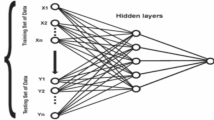Abstract
The coordinated forecast of agricultural means supply chain not only needs cooperation and information sharing among different parties but also needs scientific forecast methods and means. This paper firstly builds the synergetic framework of demand forecast and analyzes the key factors of demand forecast coordination in different forecast stages and then confirms duplicate combined forecast method for time series based on the factors which influence the demand of agricultural means. GM(1,1) is used in the model to forecast the fluctuant items of long-term trend; BP neural network and ARMA are used to simulate periodically fluctuant items. Particle swarm algorithm is used to confirm the combined forecast model of periodically fluctuant items. Finally, a calculating example is used to compare the forecast precision of the combined forecast model, GM(1,1), BP neural network model and ARMA model. In conclusion, duplicate combined forecast model is applicable to forecasting the demand of agricultural means which are influenced by long-term trend and periodically fluctuant factors.



Similar content being viewed by others
References
Lee, H.L., So, K.C., Tang, C.S.: Value of information sharing in two-level supply chain. Manage. Sci. 46(5), 626–643 (2000)
Ali, M.M., Mohamed, Z.B., John, E.B., Syntetos, A.A.: Supply chain forecasting when information is not shared. Eur J. Op. Res. 3(26), 984–994 (2017)
Helena, F., Patrik, J.: The impact of forecast information quality on supply chain performance. Int. J. Op. Prod. Manag. 27(1), 90–107 (2007)
Dong, S.H., Zhang, Z.Q., et al.: Research on supply chain coordination demand forecasting mechanism. Op. Manag. 19(5), 66–72 (2010)
Shu, T., Chen, S., et al.: Supply chain collaborative forecasting method based on impact factors. Syst. Eng. Theory. Pract. 30(8), 1364–1375 (2010)
Kinbrough, S.O., Wu, D.J., Zhong, F.: Computers play the beer game: can artificial agents manage supply chains. Decis Support. Syst. 33(3), 323–333 (2002)
Rajesh, R.: Forecasting supply chain resilience performance using grey prediction. Electron. Commer. Res. Appl. 11(20), 42–58 (2016)
Li, G., Gao, T., et al.: Supply collaboration in supply chain under uncertain delivery time and BOM pay-on-produce mode. Comput. Integr. Manuf. Syst. 17(2), 369–379 (2011)
Chen, F., Drezner, Z., Ryan, J.K., Simch-iLevi, D.: Quantifying the bullwhip effect in a simple supply chain: the impact of forecasting, lead times, and information. Manag. Sci. 46(3), 436–443 (2000)
Joshi, K., Singh, K.N., Kumar, S.S.: Two sided supplier manufacturer selection in BTO supply chain. J Model. Manag. 7(3), 257–273 (2012)
Cheng, C.S., Duan, X.L.: Qd-Ps combined contracts model in three-level supply chain under stochastic demand. J. Changsha. Univ. Sci. Technol. (Natural Science). 10(3), 30–38 (2013)
Feng, Y., Ma, J.H.: Research on nonlinear method of supply chain demand forecasting. J. Beijing. Inst. Technol. 10(5), 82–86 (2008)
Sun, Q., Zhao, Y., Meng, X.F.: Optimization of calibration interval optimization based on gray combinatorial model. J. Syst. Simul. 29(5), 2296–2299 (2008)
Zhang, Y.D., Wu, L.N.: Stock market prediction of S & P 500 via combination of improved BCO approach and BP neural network. Expert. Syst. Appl. 36(5), 8849–8854 (2009)
Zhang, G.P., Qi, M.: Neural network forecasting for seasonal and trend time series. Eur. J. Op. Res. 160, 501–514 (2005)
Song, X.L., Zheng, L.Y., Chen, S.F., Xu, B.: Gray combination double trends time series prediction model. Comput. Eng. Appl. 47(8), 115–117 (2011)
Deng, J.L.: A novel grey model Gm(l,1/x, r): generalizing GM(1, l). J. Grey. Syst. 13(1), 1–8 (2001)
Yang, H.L., Liu, J.X., Zheng, B.: Improvement and application of gray prediction GM(1,1) model. Math. Pract. 41(23), 39–46 (2011)
Zhou, Q., Luo, J.: Artificial neural network based grid computing of E-government scheduling for emergency management. Comput. Syst. Sci. Eng. 30(5), 327–335 (2015)
Xie, J., Luo, J., Zhou, Q.: Data mining based quality analysis on informants involved applied research. Clust. Comput. 19(4), 1885–1893 (2016). https://doi.org/10.1007/s10586-016-0657-7
Zhou, Q.: Multi-layer affective computing model based on emotional psychology. Electron. Commer. Res. 18(1), 109–124 (2018). https://doi.org/10.1007/s10660-017-9265-8
Zhou, Q., Luo, J.: The risk management using limit theory of statistics on extremes on the big data era. J. Comput. Theor. Nanosci. 12, 6237–6243 (2015). https://doi.org/10.1166/jctn.2015.4661
Chen, Y.H., Gan, A.P.: Improvement and application of gray wave prediction model. Stat. Decis. 450(6), 75–78 (2016)
Acknowledgement
The work was supported by the project of Social Science Foundation of Hebei Province-“Empirical Study and Policy Choice of Synergetic Development of Regional Logistics Capability and Regional Economic System in Hebei Province” (HB15YJ024), and 2018 Hebei Science and Technology Department of soft science research and science projects-“Research on the Implementing Path and Policy Innovation of Supply-side Structural Reform of Logistics Industry in Hebei Province”.
Author information
Authors and Affiliations
Corresponding author
Rights and permissions
About this article
Cite this article
Zhu, Y., Li, S. & Peng, Y. Research on duplicate combined forecasting method based on supply chain coordination. Cluster Comput 22 (Suppl 3), 6621–6632 (2019). https://doi.org/10.1007/s10586-018-2356-z
Received:
Revised:
Accepted:
Published:
Issue Date:
DOI: https://doi.org/10.1007/s10586-018-2356-z




